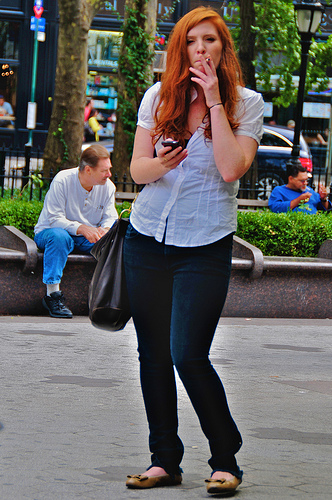In the previous post I discussed my difficulty in solving my running-related pain issues. Analyzing and changing one’s running technique is a challenging thing, but I’m going to attempt it. I’m mainly going to discuss running here but these concepts apply to walking as well. (Don’t think that poor walking mechanics don’t matter. We spend a lot of time walking. If we’re doing it wrong then we’re really hammering the body into a mangled mess.)
Really important thing #1: Let the foot drop right below you. Don’t reach out with your heel.
It’s vital to get the foot strike correct when running. I now realize that for years I was reaching forward with my leg, putting my heel out in front of me, and hitting the ground with my heel. This is bad. It promotes overuse of the hamstring muscles and de-emphasizes the glutes.
I then spent the past year to year-and-a-half trying a forefoot strike. I thought this was an effective correction of my heel strike but I was still doing several things wrong. First, I was still reaching out ahead of me. As a result I was still using my hamstrings too much and I wasn’t using my glutes enough. And though I was hitting with my forefoot and avoiding a heel strike, I wasn’t allowing my heel to settle to the ground.
Now I’m doing things a lot better. First, I drop my foot directly below me. In fact, it feels like my foot is dropping behind me. Let me emphasize the word “drop.” I passively let the leg unfold underneath me and let gravity pull my foot to the ground. I don’t actively try to do much of anything with my foot. I often pay attention to how things feel down there but I don’t try to pull my foot off the ground or push off in any particular way. Steve Magness discusses this process in is superb post How to run with proper biomechanics. I’ve bolded the key points:
Once the knee has cycled through, the lower leg should drop to the ground so that it hits close to under your center of gravity. When foot contact is made, it should be made where the lower leg is 90 degrees to the ground. This puts it in optimal position for force production. The leg does not extend outwards like is seen in most joggers and there is no reaching for the ground. Reaching out with the lower leg results in over striding and creates a braking action. Another common mistake is people extending the lower leg out slightly and then pulling it back in a paw like action before ground contact. They are trying to get quick with the foot and create a negative acceleration. This is incorrect and does not lead to shorter ground contact times or better positioning for force production. Instead the paw back motion simply engages the hamstrings and other muscles to a greater degree than necessary, thus wasting energy. The leg should simply unfold and drop underneath the runner.
I know I’m running well when it actually feels like the foot is dropping behind me. (It’s not actually behind me, it’s just dropping quite a bit further back than it used to.) I now focus on hip extension when I run, or using my glutes to drive my leg back. With this proper foot placement I can feel my glutes turn on and propel me forward. It helps to have a slight forward lean through this process.
Really important thing #2: Lengthen through the hip
This concept of what I call “lengthening through the hip” has had a massive impact on my walking and running technique and thus my pain issues as well. Denver-area physical therapist Rick Olderman helped me solve a strange little bodily riddle I’d had for years, and this hip lengthening process was right at the core of it.
For a long time I noticed that standing on my right leg was a lot different from standing on my left. When I would stand on my right leg I always sort of tipped or shifted to the right. It didn’t feel right. My balance would shift in a sort of exaggerated way. This was happening every step. Standing incorrectly on my right leg when walking and running also meant I would land badly on my left leg. Lengthening up and pressing my weight through my hip into my foot solved this issue.
This concept is a little tough to effectively describe in words but here goes: As my foot hits the ground below me, I think of lifting my trunk away from hip. In my mind the hip and the rib cage of the stance leg are separating–moving away from each other, and I’m sort of getting taller in the process. I don’t think of bounding or hopping though. I’m trying to make my leg longer below me and behind me as I move forward. A slight lean forward from the ankles helps me do this all correctly.
This movement is sort of a subtle kind of thing to grasp. Describing this process is sort of like describing chocolate to someone who’s never tasted it. It’s not like simply flexing your elbow or bending your knee. It’ll probably take a bit of practice to get a feel for this. The goal should be to take this strange-feeling novel movement and turn it into a habit. The video below should help explain this.

